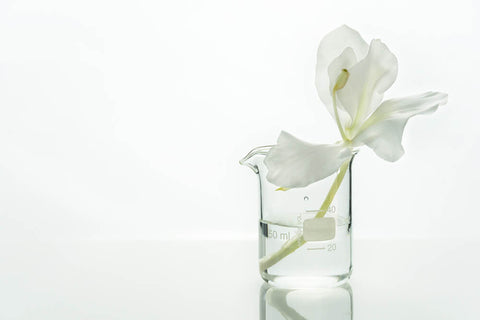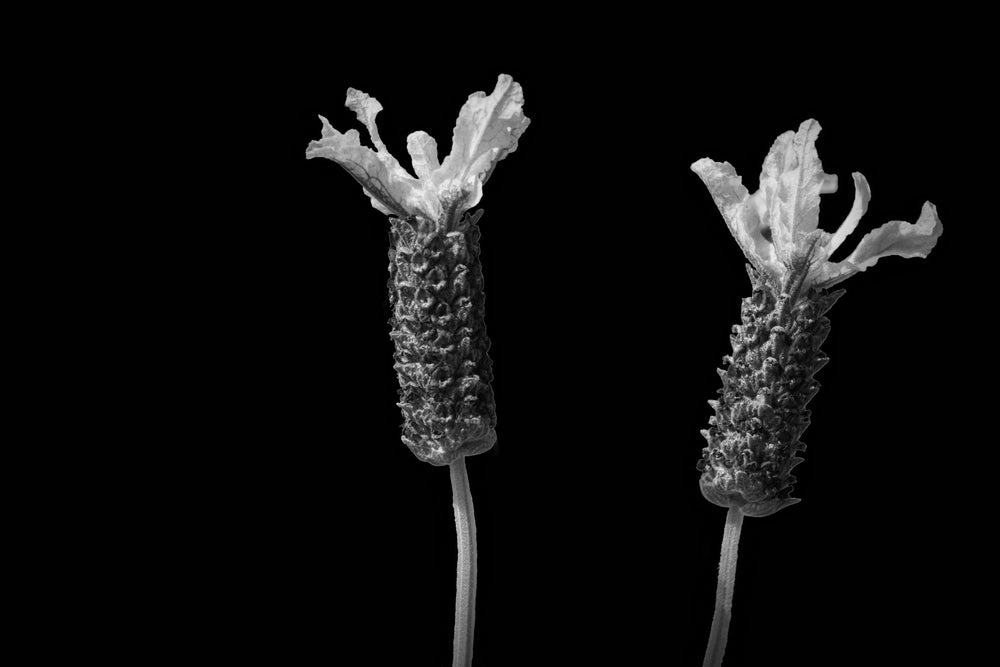
ingredient focus: panthenol

the bottom line
A member of the B family of vitamins, panthenol, or provitamin B5, has its own unique profile. Used in both skin and haircare products, panthenol has been shown to draw moisture into the skin, restore the skin barrier, assist in wound healing, and improve hair’s shine and strength. Keep reading to learn more about the history and science behind this essential vitamin.
first layer: the history of panthenol
Discovered in 1933 by American biochemist Roger John Williams, the name “pantothenic acid” is derived from the Greek word pantothen – “from everywhere”, indicating its universal presence. Panthenol was initially found in plants in the form of a clear, viscous substance.
second layer: the science of panthenol
Panthenol is a plant-derived provitamin of B5. Pantothenic acid, or vitamin B5, is a natural ingredient found in egg yolks, yeast, wholegrain cereals, and legumes. Panthenol comes in two forms, dextropanthenol (d-panthenol) and levopanthenol (l-panthenol). d-panthenol is converted to d-panthothenic acid, a biologically active molecule, while l-panthenol is not. d-panthenol is a precursor of coenzyme A, which in turn catalyzes the synthesis of fatty acids and sphingolipids* which are critical to the lipid layers of the stratum corneum*.
Panthenol is easily absorbed into the skin and metabolized into pantothenic acid (vitamin B5) where it acts as a moisturizer. One study showed that panthenol increases the molecular mobility of lipid and protein portions of the stratum corneum, which in turn improves skin hydration. Pro-vitamin B5 is also capable of penetrating the cortex of the hair shaft, improving the hair’s shine, flexibility, and resistance to environmental stress.
d-panthenol is believed to exhibit activity across all three phases of wound healing: inflammation, proliferation, and remodeling. d-panthenol assists in wound healing by increasing fibroblast* proliferation and the acceleration of epithelialization*. In one study, dermal fibroblasts treated with calcium pantothenate were shown to upregulate the expression of IL-6 and IL-8, cytokines* strongly expressed during wound healing. In another study, the gene expressions of IL-1 alpha, a proinflammatory cytokine, and matrix metalloproteinase 3 (MMP3)*, a regulator of wound healing, were also upregulated following exposure to d-panthenol.
third layer: panthenol in skincare
Panthenol is used in skincare products for multiple purposes:
moisturization: One study evaluated the use of d-panthenol for the treatment of atopic dermatitis* and found that twice-daily application of 2.5% d-panthenol over seven days resulted in improvement of hydration of the stratum corneum and reduced transepidermal water loss (TEWL) when compared to controls. Another study evaluating the hydrating effect of d-panthenol used both 1% and 5% formulations and found significant decreases in TEWL after 15- and 30-day periods of application as compared to baseline.
skin barrier* restoration: A study evaluated damaged human skin after treatment with a 5% d-panthenol solution applied twice daily. They noted enhanced skin barrier repair and stratum corneum hydration. A separate study evaluating the treatment of superficial wounds demonstrated that wounds treated with d-panthenol showed a reduction in redness and more elastic tissue regeneration. Finally, a multicenter study in which patients with atopic dermatitis, ichthyosis*, psoriasis*, and contact dermatitis were treated with a topical formulation of d-panthenol. All symptoms of dryness, scaling, pruritus (itching), and erythema (redness) improved by over 80% over the course of 3-4 weeks.
wound healing: Following procedures, panthenol has been shown to be helpful in speeding wound healing as well as improving local hydration. A study in which a 5% ointment of d-panthenol was applied to skin graft donor sites for 14 days following surgery showed more rapid healing and significantly greater hydration than in nontreated sites.
fourth layer: how we do it
Panthenol is a key ingredient in our jasmine serum. Created as a moisturizer for sensitive skin, it’s also been used by many of our customers to soothe skin and speed healing following facial rejuvenation procedures including laser, micro needling, and Fraxel. With hyaluronic acid, panthenol, jasmine, sandalwood, and sweet almond oil, it’s a gentle and fragrant layer for your morning routine.
All this and more at www.anokhaskincare.com .
xx
anokha
references:
- Janes D, Kocevar Glavac N. “Provitamin B5 (Panthenol)”, in Modern Cosmetics. 2018. Velenje, Slovenia: Sirimo dobro besedo, d.o.o., pp. 272-273.
- com
- Proksch E, de Bony R, Trapp S, Boudon S. Topical use of dexpanthenol: a 70th anniversary article. J Dermatol Treat 2017; 28)8): 766-773.
- Proksch E, Nissen HP. Dexpanthenol enhances skin barrier repair and reduces inflammation after sodium lauryl sulphate-induced irritation. J Dermatol Treat 2002; 13: 173-178.
- Weimann BI, Herrmann D. Studies on wound healing: effects of calcium D-pantothenate on the migration, proliferation and protein synthesis of human dermal fibroblasts in culture. Int J Vitam Nutr Res 1999; 69: 113-119.
- Wollina U, Kubicki J. Dexpanthenol supports healing of superficial wounds and injuries. Kosm Med 2006; 27: 240-249.
- Bjorklund S, Pham QD, Jensen LB et al. The effects of polar excipients transcutol and dexpanthenol on molecular mobility, permeability, and electrical impedance of the skin barrier. J Colloid Interface Sci 2016; 479: 207-220.
- Gehring W, Gloor M. Effect of topically applied dexpanthenol on epidermal barrier function and stratum corneum hydration. Results of a human in vivo Arzneimittelforschung 2000; 50: 659-663.
- Camargo FB Jr, Gaspar LR, Maia Campos PM. Skin moisturizing effects of panthenol-based formulations. J Cosmet Sci 2011; 62: 361-370.
- Wiederholt T, Heise R. Skazik C, et al. Calcium pantothenate modulates gene expression in proliferating human dermal fibroblasts. Exp Dermatol 2009; 18: 969-978.
- Gorski J, Proksch E, Baron JM, Schmid D, Zhang L. Dexpanthenol in wound healing after medical and cosmetic interventions (postprocedure wound healing). Pharmaceuticals 2020; 13: 138-150.
- Baron JM, Glatz M, Proksch E. Optimal support of wound healing: New insights. Dermatol 2020; 1-8.
- Gill SE, Parks WC. Metalloproteinases and their inhibitors: Regulators of wound healing. Int J Biochem Cell Biol 2008; 40: 1334-1347.
- Girard P, Beraud A, Goujou C, et al. Effet de Bépantène® onguent sur le modèle de cicatrisation du site de prélèvement de greffe : Étude biométrologique, clinique et évaluation par le patient, en double aveugle contre véhicule. Nouv Dermatol 1998 ; 17 : 559-570.
- Ebner F, Heller A, Rippke F, Tausch I. Topical use of dexpanthenol in skin disorders. Am J Clin Dermatol 2002; 3(6): 427-433.
*definitions:
atopic dermatitis: a type of eczema notable for red, flaky, itchy skin, typically affecting the inner elbows and behind the knees. It’s often seen in conjunction with allergic rhinitis, hay fever, and asthma.
cytokine: cytokines are small proteins that are required to control the growth and activity of other immune system cells and blood cells. cytokines affect the growth of blood cells and other cells crucial to the body’s immune and inflammation responses.
epithelialization: the process of covering open wounds with migration of cells to the open surface.
fibroblast: a cell that contributes to the formation of connective tissue within the body. fibroblasts secrete collagen proteins which help to maintain the structural framework of the tissues.
ichthyosis: a group of skin disorders characterized by dry, scaly, or thickened skin.
matrix metalloproteinase (MMP): a member of a group of enzymes that can break proteins such as collagen or elastin. they can be overstimulated by internal or external agents to break down healthy proteins.
psoriasis: a skin disease characterized by a rash with itchy and scaly patches, typically found on the knees, elbows, trunk, and scalp.
skin barrier: the skin barrier protects against external agents including mechanical and chemical insults, heat, pathogens, water, and radiation.
sphingolipids: phospholipids that maintain structural integrity within cell membranes.
stratum corneum: the outermost layer of the epidermis that marks the final stage of keratinocyte maturation and development.
transepidermal water loss (TEWL): the normal movement of water from the stratum corneum to the atmosphere
faq’s:
what is panthenol?
panthenol is a plant-derived provitamin of B5.
is panthenol good for hair?
panthenol helps to strengthen the hair, improves elasticity, and adds strength.
what are some panthenol skin benefits?
panthenol has been shown to improve moisturization of the skin, help restore the skin barrier, and promote wound healing.
what is d-panthenol?
d-panthenol is also known as dextropanthenol, which refers to the enantiomeric form of the panthenol molecule.



Hinterlasse einen Kommentar
Diese Website ist durch hCaptcha geschützt und es gelten die allgemeinen Geschäftsbedingungen und Datenschutzbestimmungen von hCaptcha.